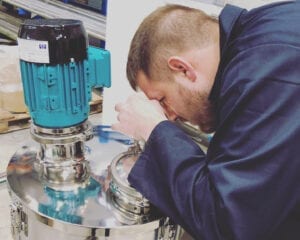Choosing your Vessels & Mixers
Whatever your vessel needs, the Adelphi Group of Companies can recommend or design the solution that best matches your requirements. Below are some key areas that must be considered before making a purchase…
1. Vessel Capacity
Vessel capacity must be considered in two ways; maximum and minimum working capacity. Our standard vessels have their capacity listed as ‘brim full’ – we tell you the total overall volume of space in the vessel. However, maximum capacity must allow for 10-20% free space below ‘brim full’, so that if product is being mixed and stirred, there is no overspill. Minimum capacity refers to a figure no less than 5% of maximum working capacity.
2. Vessel Bottom
Standard vessels have flat bottoms, which makes draining to completely empty difficult. Our standard vessels can be modified to have a sloped bottom at 3 degrees, with the valve welded to the bottom edge, which reduces leftover product pooling when draining your vessel. Normally, this modification is suitable for vessels of 50L capacity or above. Vessels can also be custom made with a cone or dish shaped bottom, whereby a valve can be positioned in the centre of the base to allow full draining.
3. Stainless Steel Grade
We offer vessels in 304 or 316L (pharmaceutical grade) stainless steel.
A simple description of the difference is that 304 grade contains 18% chromium and 8% nickel, while 316 grade contains 16% chromium, 10% nickel and 2% molybdenum. The molybdenum is added to help resist corrosion to chlorides. Vessel parts which will never come into contact with your product are often made in 304 grade, to reduce costs. With the use of our X-Ray analyser, we can provide full traceability on our material, accompanied with the relevant certification.
4. Outlets
When draining your product from the vessel/mixer into containers, valve outlet types include taps, butterfly valves or ball valves. We can advise you of the valve type best suited to your product. The connection positions of these outlets must also be considered; they can be on the bottom or side walls depending on your requirements.
5. Seal Type
The material of your seal must be compatible with your product; PHP are able to provide full guidance on this. Viton (Fluoroelastomer) is generally a good choice for most applications. Silicone seals are a popular choice for pharmaceutical customers, but this material can be incompatible with some solvents. The full list of seal material options also includes Silicone, Viton, EDPM, Nitrile Rubber and PTFE Encapsulated Viton.
6. Lids
There are several types of lids for your vessels. Standard lids are pressed or spun. These fit inside the vessel, and can be supplied with a seal if required. Simple drop-on lids have a lip that fits on the outside of the vessel; these are used as dust covers. Dished lids can be made with an inner and outer lip, and a seal between the two lips. A split lid can be made with a 1/3 opening. We can also modify your lid if a hole or funnel is needed, or add toggles to hold the lid in place.
7. Mixer Type
In order for us to accurately recommend the correct mixer type, it is essential that we are provided with information about the type of product you wish to mix. Viscosity is a vital consideration, as is whether any powders are being added, which may dissolve easily or may form lumps. Product addition ports can also be added to aid the pouring of products into the mixer.
8. Dip Sticks
Dip sticks can be used to measure liquid within the vessel. They can be mounted on the lid with a Tri-Clover port. On simple vessels, a side hanging dip stick can be hung on the vessel wall, provided the lid selection is compatible.
9. Product Inspection
For a visual aid to checking the quality of your product is as you would like it, lid-mounted sight glasses and light can be included if needed.

10. Any Other Business
Lastly, please don’t forget to let us know if you have any special requirements for your product or vessel,
the main examples of which are:
Flammable products
ATEX is the name commonly given to the European Directive for controlling explosive atmospheres. Our vessels can be adapted to comply with directive 94/9/EC (also known as ‘ATEX 95’ or ‘the ATEX Equipment Directive’) on the approximation of the laws of Members States concerning equipment and protective systems intended for use in potentially explosive atmospheres. Zone 1 CAT II 2C DG T4 (135 degrees Celsius).
Temperature control
We can supply water jacketed and pressure vessels for heating, cooling or maintaining the temperature of your product.
Documentation
We can provide material certificates for product contact parts and internal surface finish certificates, as well as TSE certificates if required.
